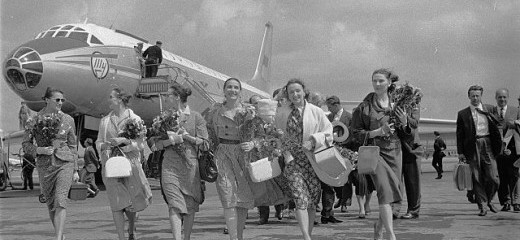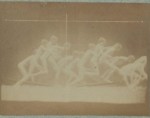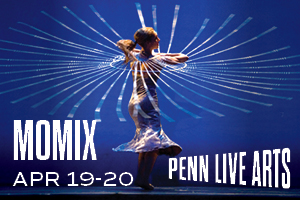
Dance: Soft Diplomacy in the Cold War
by Lynn Matluck Brooks
Two years after the stimulating symposium, Russian Movement Culture of the 1920s and 1930s, the Harriman Institute at Columbia University has produced another remarkable gathering, under Lynn Garafola’s direction, of scholars and artists, this time digging into the topic Dancing the Cold War. Having attended and written about the earlier symposium, I anticipated that the Cold War conference would be at least as provocative. It was.
In the course of the symposium, attendees heard from scholars and artists in a range of fields as they pondered the Cold War not only as a political force, but also as a shaper of individual lives, collective lives, national identities, art-making, and arts policies. Having grown up as a child of the Cold War, I remember the bomb drills in elementary school (huddle under desk with sweater pulled over head), Kennedy’s address to the nation during the Cuban Missile Crisis, Nikita Khrushchev’s shoe-brandishing U.N. speech, and the marches by young Americans protesting arms proliferation. Stimulated by this symposium, I remember even more about growing up in those fearsome times, but these awakened memories are now nuanced by understanding how leaders East and West saw art as a means of breaching ideological barriers, of experiencing the humanity of the Other, of softening explosive political tensions through state-sponsored artistic exchange. The symposium also revealed four perspectives unfamiliar to me: the Cold War pop scene, artistic diplomacy in territories beyond the U.S. and U.S.S.R., artists’ experiences, and the role of archives and documentation in managing historical memory.
Jens Richard Giersdorf revealed the drive of East German authorities to squelch teenagers’ thirst for American rock ‘n’ roll by prescribing “authentic” folk dances, which of course failed to capture popular enthusiasms. Julia Foulkes discussed West Side Story’s complex evolution in handling Cold War themes represented in the musical itself and in U.S.–Soviet tensions over touring the show behind the Iron Curtain. Disco’s magnetic draw on Ukrainian youth was the subject of Sergei Zhuk’s entertaining, if circuitous, reminiscence. And Marsha Seifert reported on popular Soviet-made dance biopics, particularly the 1983 Anna Pavlova.
Carrying the Cold War beyond the U.S.–Soviet confrontation were papers covering nearly every continent. Eva Shan Chou’s discussion of ballet in China explored the tensions between Chinese and Soviet arts policies and artistic influences. In some ways the strained relations were similar to those experienced in Cuba, as discussed by Elizabeth Schwall, although the powerful Alonso clan retained dominant control of the Caribbean nation’s ballet enterprise. Stephanie Gonçalves told the tragic story of the French defeat at Dien Bien Phu, Vietnam, resulting in cancellation of the Bolshoi Ballet’s Paris season of 1954. Africa felt the influence of American visitors Katherine Dunham, Pearl Primus, and Alvin Ailey and company, which, Joanna Dee Das noted, aroused not only excitement among West Africans, but also, at times, anxiety and even resentment.
A highlight of the symposium was Saturday’s panels with artists who share Cold War dance legacies. The morning began with a stellar line-up of American dancers who told of their exciting, exasperating, and sometimes heartrending encounters traveling on State Department tours to Eastern Europe, the Middle East, Africa, South America, and Asia as dancers and, inevitably, as diplomats of sorts. Linda Hodes of the Martha Graham Company recalled the nonstop laughter of young Burmese monks as they watched Diversion of Angels, while New York City Ballet’s Allegra Kent remembered that Russian musicians, having never played Stravinsky, were first exposed to his music when Balanchine’s dancers appeared in the Soviet Union. Suki Shorer, a high schooler when she first toured with San Francisco Ballet to the Middle East, collected and saved mementos and photos that she graciously shared at the symposium, as did Suzanne Hammons, who toured with both SFB and the Joffrey Ballet. Hammons shared the moving story of being on tour in the U.S.S.R. when news of the Kennedy assassination broke; the sorrow of the dancers was shared by Russian citizens who flocked to a church which had been opened for the dancers to gather and mourn. Another moving story was Kay Mazzo’s memory of the Berlin Wall, which was completed and sealed while she was on tour in that city; she was overwhelmed by the deep sadness and fear that swept the population. Sylvia Waters, of the Ailey company, recalled not only the food hardships of the tour (a common theme among the dancers), but also the warm ovations of the audiences (also widely remembered) and the stringent restrictions placed on the dancers’ actions and encounters with locals (another shared experience). Trinette Singleton of Joffrey and Carla Maxwell, longtime standard-bearer of the Limón company, spoke about the layers of auditions and approvals each dance work had to pass, on both the American and the Soviet sides, before making it to the touring stage. Dancers were ambassadors for their art in the U.S. as well as in Russia, Carolyn Adams of the Taylor company recalled, and Karen Brown of Dance Theatre of Harlem remembered the huge pride that director Arthur Mitchell felt, as a “son” of Balanchine, bringing his own company to Russia.
Finally, the erasure, shaping, and revival of memory was a subject discussed by Irina Klyagin of Harvard Theatre Collection, telling of her work in once-secret archives of Russia, where many items stowed on inaccessible shelves were stamped as “gifts” from the Russian secret service—a code for items confiscated from executed prisoners. Maria Ratinova of the Harriman Institute used the example of Sleeping Beauty to discuss the losses and resurrections of versions of this great Petipa/Tchaikovsky ballet—and by implication, other works. The day closed with a wonderfully open discussion by choreographer Alexei Ratmansky about his recent work on Soviet-era ballets such as The Bright Stream and Bolt (both with music by Shostakovich), as well as his new Sleeping Beauty, in all of which he drew varied inspiration from music, written documentation, the dancers, personal experience, and his own creative intelligence.
Coach and teacher Elena Kunikova, a St. Petersburg dancer who had admired the Americans on their Soviet tours and now shares her meticulous Russian training and repertory knowledge with American dance companies, best summed up the symposium’s truths for me: forget about “six degrees of separation,” she remarked. We are all dancers, and more fundamentally, all human beings, to whom art can speak with vivid and ideology-destroying honesty.
Dancing the Cold War: An International Symposium, Columbia University, Harriman Institute, February 16-18.
By Lynn Matluck Brooks
February 23, 2017






.png)


